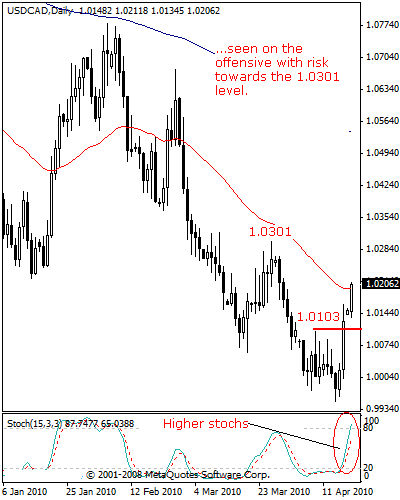USDCAD- The pair is on the offensive following its two-day of recovery started at the 0.9961 level, its April 15’10 low. With USDCAD failing to hold below its parity level leading to the present recovery, we are likely to see further strength towards the 1.0301 level, its Mar 26’10 high. A breather could occur there and turn the pair back down but if that fails to occur, the pair should head further higher towards its Feb 22’10 low at 1.0368 and possibly higher. The daily momentum indicators are bullish supporting this view. On the downside, support initially comes in at the 1.0103 level, its April 08’10 with a break below there exposing the 1.0000 level where we may see price hesitation again. Further out, the 0.9951 level, its 2010 low will be the next support followed by its July’08 low at 0.9818 and then the 0.9707 level, its Feb’08 low. In a summary, although USDCAD remains biased to the downside medium term, its inability to hold below the 1.0000/0.9951 levels has triggered a corrective recovery.
USDCAD: Recovery To Aim At The 1.0301 Level.
USDCAD- The pair is on the offensive following its two-day of recovery started at the 0.9961 level, its April 15’10 low. With USDCAD failing to hold below its parity level leading to the present recovery, we are likely to see further strength towards the 1.0301 level, its Mar 26’10 high. A breather could occur there and turn the pair back down but if that fails to occur, the pair should head further higher towards its Feb 22’10 low at 1.0368 and possibly higher. The daily momentum indicators are bullish supporting this view. On the downside, support initially comes in at the 1.0103 level, its April 08’10 with a break below there exposing the 1.0000 level where we may see price hesitation again. Further out, the 0.9951 level, its 2010 low will be the next support followed by its July’08 low at 0.9818 and then the 0.9707 level, its Feb’08 low. In a summary, although USDCAD remains biased to the downside medium term, its inability to hold below the 1.0000/0.9951 levels has triggered a corrective recoveryUSDCAD- The pair is on the offensive following its two-day of recovery started at the 0.9961 level, its April 15’10 low. With USDCAD failing to hold below its parity level leading to the present recovery, we are likely to see further strength towards the 1.0301 level, its Mar 26’10 high. A breather could occur there and turn the pair back down but if that fails to occur, the pair should head further higher towards its Feb 22’10 low at 1.0368 and possibly higher. The daily momentum indicators are bullish supporting this view. On the downside, support initially comes in at the 1.0103 level, its April 08’10 with a break below there exposing the 1.0000 level where we may see price hesitation again. Further out, the 0.9951 level, its 2010 low will be the next support followed by its July’08 low at 0.9818 and then the 0.9707 level, its Feb’08 low. In a summary, although USDCAD remains biased to the downside medium term, its inability to hold below the 1.0000/0.9951 levels has triggered a corrective recovery.

This is an excerpt from FXT Technical Strategist Plus (The Professional Suite package), a 7-currency model analysis utilized by all levels of traders. View the service information
This report is prepared solely for information and data purposes. Opinions, estimates and projections contained herein are those of FXTechstrategy.com own as of the date hereof and are subject to change without notice. The information and opinions contained herein have been compiled or arrived at from sources believed to be reliable but no representation or warranty, express or implied, is made as to their accuracy or completeness and neither the information nor the forecast shall be taken as a representation for which FXTechstrategy.com incurs any responsibility. FXTstrategy.com does not accept any liability whatsoever for any loss arising from any use of this report or its contents. This report is not construed as an offer to sell or solicitation of any offer to buy any of the currencies referred to in this report




